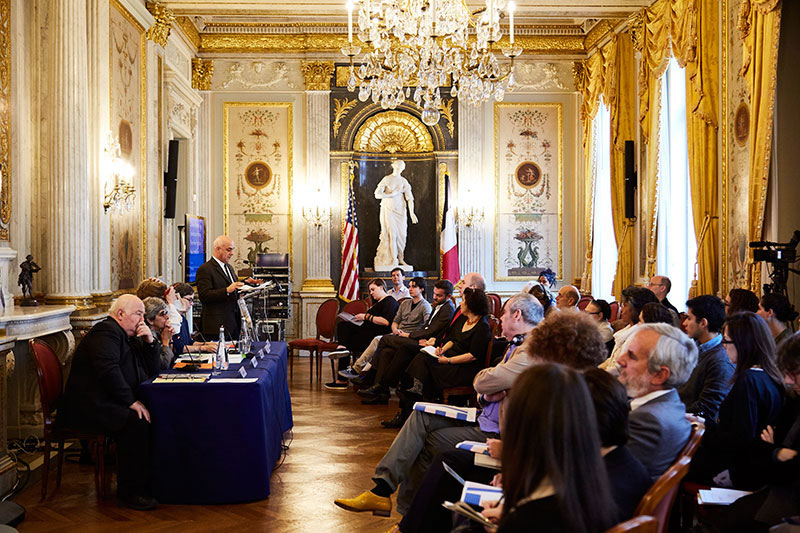
Parsons Paris and NSSR Honor Tradition of Tackling Refugee Issues
At the height of World War II, dozens of scholars fled Nazi-occupied France for New York City, finding refuge at the École Libre des Hautes Études (ELHE). Housed at The New School for Social Research (NSSR) — a graduate school founded as an academic haven for scholars escaping tyrannical regimes in Europe — the institution became part of a long and robust tradition of confronting issues around refugees and migration at The New School.
Today students and faculty members in various disciplines across the university and its sister campus, Parsons Paris, continue to uphold that tradition in a variety of ways: A fashion designer created an outwear collection to help Syrian refugees, activists embarked on an international field program exploring refugee routes in the Balkans, and scholars launched a center to study migration and mobility.
Recently students and faculty members at the university celebrated The New School’s dedication to engaging refugee and migration issues, as well as the anniversary of the ELHE, at Memories and Politics of Exile.
Hosted by Parsons Paris, in collaboration with the École des Hautes Études en Sciences Sociales (EHESS) and NSSR, the symposium featured guest speakers, professors, and scholars in discussion on the European refugee crisis, how it connects to The New School’s history of welcoming exiled scholars, and the potential for design to address pressing issues around refugees and migration.
“Parsons Paris initiated this conference to recall the history of the ELHE, which was deeply important for the development of intellectual history and social science at The New School and in France,” says Susan Taylor-Leduc, dean of Parsons Paris. “This symposium gave students at our design school an opportunity to reflect on the past while addressing the implications for today’s refugee crisis.”
“The ELHE was an integral part of The New School and represented part of the grand New School tradition of cosmopolitanism, academic freedom, and openness to exiled scholars,” says Will Milberg, dean of NSSR. “We are proud of this tradition, in particular at a time when the world is experiencing a new wave of refugees and forced migrants. The celebration in Paris allowed us to both recall the tradition and grapple with how to update it in the 21st century.”
In his lecture, “What Design Can Do for Refugees,” social entrepreneur Dagan Cohen highlighted the importance of designing for social needs.
“We see a movement from aesthetics to ethics,” said Cohen, leader of What Design Can Do: Refugee Challenge. “Designers are great collaborators and have the ability to simplify complex issues.”
Students at The New School and Parsons Paris have done just that. At Parsons Paris, students in the Civic Design Lab use design to address pressing issues related to migration, urbanization, and sustainability. At The New School, Angela Luna, Fashion Design ’16, created an award-winning outerwear collection designed to help refugees.
The New School’s commitment to confronting refugee and migration issues extends beyond design to the social sciences, international affairs, and media and technology. In 2014, The New School launched the Zolberg Institute on Migration and Mobility, a global center for academic research, policy debate, and discussions of global migration and mobility, their economic impact, and their political consequences. The center recently received a generous gift from New School trustee Henry Arnhold to help turn the institute into a world-class research center.
In addition, students in the International Field Program of the Julien J. Studley Graduate Program in International Affairs recently traveled to Turkey, Greece, Bulgaria, and Serbia to follow a refugee route, visit refugee camps, and study resettlement policy. They have since shared their findings, which in part detail the experience of refugees traveling and living in those countries.
Memories and Politics of Exile was The New School’s latest activity focusing on refugee and migration issues. The symposium featured panel discussions on the experiences of scholars in exile, as well as the history of migration during World War II. An interactive reconstruction of the “left-to-die boat” case highlighted the plight many migrants face as they attempt to flee their own countries in poorly designed rafts, while a new exhibition at the Parsons Paris Gallery featured works that focus on defining the issues of today’s migrant crisis.
An interactive workshop led by the Rockefeller Archive Center gave students the opportunity to study archives that detailed refugee scholar efforts during World War II. While reviewing case studies presented to the Rockefeller Foundation, students analyzed criteria for allocating life-saving visas in the 1940s.
Students also listened to scholars and historians exploring the common French and American tradition of welcoming foreigners and the abandonment of that tradition, as reflected in the hostile political and public responses to the contemporary migrant crisis taking place along the U.S.-Mexico border and the Mediterranean and Balkan routes into the European Union.
“At Parsons Paris, the massive migrations of the 21st century can be framed as this century’s major design challenge,” Taylor-Leduc says. “We hope our students were inspired to become actively engaged in designing solutions for this crisis.”